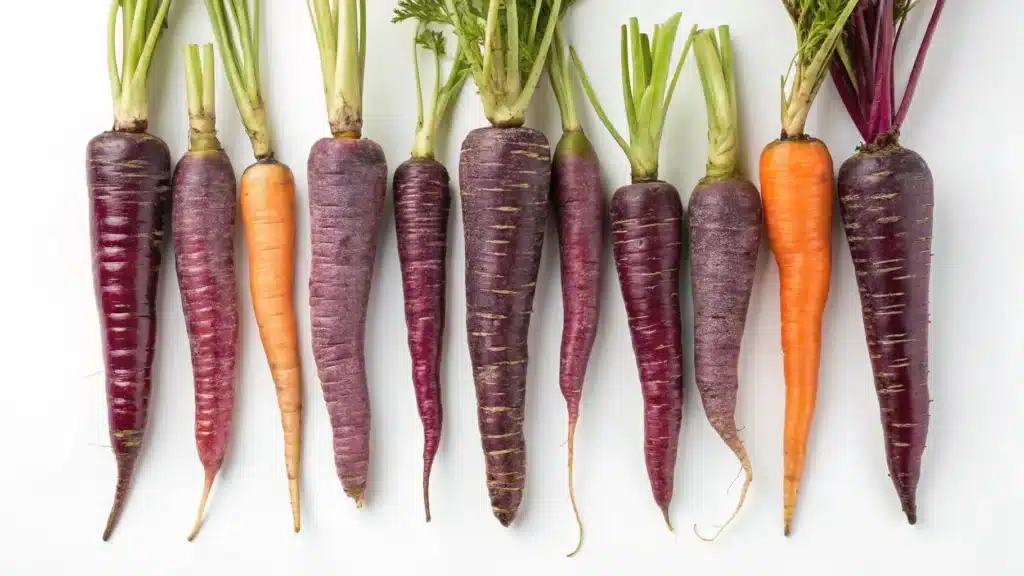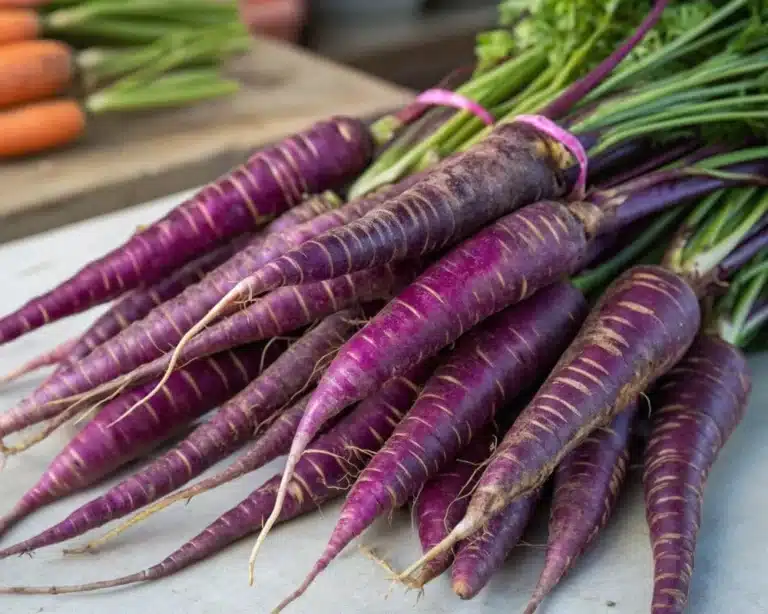Purple carrots are making a comeback in gardens everywhere. These colorful veggies aren’t just pretty to look at; they’re packed with nutrients and have a rich history. Growing them can be a fun and rewarding experience, whether you’re a seasoned gardener or just starting out. This guide will walk you through everything you need to know about planting, growing, and enjoying these vibrant carrots.
Table of Contents
Understanding the Unique Qualities of Purple Carrots
Historical Significance
Purple carrots aren’t just a colorful twist on a familiar veggie; they are, in fact, a nod to the past. Before orange carrots became the norm in the 17th century, purple varieties were widespread, especially in the Middle East and Asia. They are closer to the original wild carrots, which have been cultivated for thousands of years. This deep hue isn’t just for show; it reflects a rich history that makes purple carrots a fascinating addition to any garden.
Nutritional Benefits
When it comes to nutrition, purple carrots pack a punch. Rich in anthocyanins, these antioxidants are the same compounds that give blueberries their superfood status. Anthocyanins help protect against heart disease and may even improve memory. Besides this, purple carrots are loaded with fiber, vitamin A, and vitamin C, making them not only a feast for the eyes but also a boost for your health. If you’re looking to add more nutrients to your diet, these vibrant roots are a great choice.
Varieties of Purple Carrots

There’s more than one type of purple carrot, each with its unique taste and growth timeline. Here’s a quick look at some popular varieties:
- Purple Haze: This variety is purple on the outside and orange inside, with a sweet and slightly spicy flavor. It matures in about 70-75 days.
- Cosmic Purple: Known for its purple skin and orange core, this carrot offers a sweet and crunchy bite and matures in 70-75 days.
- Deep Purple: True to its name, this carrot is purple all the way through, offering a rich, sweet taste. It takes about 90-100 days to mature.
- Black Nebula: Almost black in color, this variety has an earthy, complex flavor and requires 70-80 days to reach maturity.
These varieties of carrot not only add color to your garden but also bring a range of flavors to your kitchen. Whether you’re looking for something sweet or with a bit of a kick, there’s a purple carrot to suit your taste buds.
Purple carrots, with their aromatic leaf and vibrant roots, are not just a feast for the eyes but a step back into history. Embrace their unique qualities and enjoy the journey of growing them in your garden.
Preparing Your Garden for Purple Carrots
Choosing the Right Soil
Picking the perfect soil is vital for growing healthy purple carrots. Loose, well-draining soil is key, as compacted or rocky soil can lead to misshapen roots. Aim for a sandy loam with a pH between 6.0 and 6.8. Before planting, remove any stones or debris and till the soil to about 12 inches deep to allow for root expansion. A fresh sage leaf can be a good companion plant, helping to deter pests naturally.
Optimal Sunlight and Watering Needs
Purple carrots thrive in full sunlight, needing at least six hours of direct sun each day. However, they can tolerate partial shade if necessary. Watering should be consistent to keep the soil moist but not waterlogged. Aim for about one inch of water per week, adjusting for rainfall. Overwatering can lead to root rot, while underwatering might stunt growth.
Spacing and Planting Techniques
Proper spacing is crucial to prevent overcrowding, which can cause stunted growth. Plant seeds about 1/4 inch deep and space them 2 inches apart. As the seedlings grow, thin them out to about 3-4 inches apart to ensure they have enough room to develop. This spacing helps promote straight and healthy carrots. Consider using row covers to protect young plants from pests and harsh weather conditions.
Preparing your garden with care will set the foundation for a successful purple carrot harvest. With the right soil, sunlight, and spacing, you’ll be on your way to growing these vibrant veggies in no time.
For better crop rotation and companion planting, consider pairing your purple carrots with Butterhead lettuce, an ideal leafy green for diverse planting
Planting and Growing
When to Plant Purple Carrots
Timing is key when planting purple carrots. These members of the carrot family prefer cooler temperatures, ideally between 60°F and 70°F. In most regions, it’s best to plant them in early spring or late summer to avoid the peak heat of summer. If you’re aiming for a fall harvest, start planting 10 to 12 weeks before the first expected frost.
Step-by-Step Planting Guide
- Prepare the soil: Purple carrots thrive in loose, sandy soil. Before planting, clear the area of rocks and debris to prevent misshapen roots.
- Sow the seeds: Plant carrot seeds about 1/4 inch deep and 2 inches apart. Rows should be spaced at least 12 inches apart to allow for growth.
- Water consistently: Keep the soil moist, especially during germination. Avoid waterlogging, which can lead to root rot.
- Thin the seedlings: Once the seedlings reach about 2 inches tall, thin them to 3-4 inches apart. This prevents overcrowding and encourages healthy root development.
Common Growing Challenges and Solutions
Growing purple carrots can come with its challenges, but with a little know-how, you can overcome them:
- Misshapen Carrots: Often caused by rocky soil or over-fertilization. Ensure your soil is well-prepared and avoid excessive nitrogen.
- Slow Growth: Compacted soil or overcrowding can slow down growth. Make sure your soil is loose and that plants are spaced properly.
- Pest Infestations: Pests like carrot flies can be a problem. Use row covers or companion planting like Chocolate mint can help deter pests naturally and improve the overall health of your carrots.For more tips on sustainable pest control, visit the EPA’s Safe Pest Control Practices page.
Pro Tip: For a sweeter taste, leave your carrots in the ground until after a frost. The cold converts some of the starches to sugars, enhancing the flavor.
Maintaining Healthy Purple Carrot Plants
Pest and Disease Management
Keeping pests and diseases at bay is crucial for thriving purple carrot plants. Watch out for common pests like carrot flies and aphids. Consider using natural deterrents such as neem oil or introducing beneficial insects like ladybugs to your garden. For disease prevention, ensure your carrots aren’t overcrowded, as good air circulation helps prevent fungal diseases.
Fertilization and Soil Care
Purple carrots thrive in well-nourished soil. Use a balanced, low-nitrogen fertilizer to avoid misshapen roots. Regularly test your soil to maintain a pH level between 6.0 and 6.8, which is ideal for these carrots. Avoid over-fertilizing, as excessive nutrients can lead to poor root development.
Mulching and Weed Control
Mulching is a simple yet effective way to retain soil moisture and suppress weeds. Apply a layer of organic mulch, such as straw or wood chips, around your carrot plants. This not only keeps the soil cool and moist but also reduces the competition from weeds, ensuring your carrots get the nutrients they need.
Keeping your purple carrot plants healthy involves a balance of proper care and timely interventions. By managing pests, maintaining the right soil conditions, and using mulch effectively, you ensure a bountiful harvest that contributes to your skin health and overall wellness.
Harvesting and Storing

Signs Your Purple Carrots Are Ready to Harvest
Purple carrots are generally ready for picking when they’ve matured between 70 to 120 days after planting, depending on the variety. You’ll know they’re ready when the tops of the carrots are about 1/2 to 3/4 inch in diameter. Gently brush away some soil to check their size. If they’re firm and have reached your desired size, it’s time to harvest.
Proper Harvesting Techniques
To ensure you don’t damage the carrots, it’s crucial to harvest them carefully. Follow these steps:
- Loosen the soil around the carrots with a garden fork or spade.
- Gently pull the carrots from the ground, holding them by the greens.
- If the soil is compacted, consider watering it lightly a day before to make the process easier.
Storing for Longevity
Once harvested, proper storage is key to keeping your carrots fresh. Here’s how to do it:
- Cut the greens off, leaving about an inch of stem to prevent moisture loss.
- Store the carrots in a cool, dark place, ideally in a refrigerator or root cellar.
- Place them in a perforated plastic bag or a container with a damp cloth to maintain humidity.
Remember, fresh carrots can last several weeks if stored correctly. Keeping them cool and moist is essential to prolong their shelf life.
By following these guidelines, you’ll enjoy the vibrant taste of your home-grown purple carrots long after harvest. Whether you’re enjoying them raw, cooked, or juiced, these colorful veggies are a delightful addition to any meal. And don’t forget, if you want to plant more, keep some carrot seeds hereor get ready for the next growing season!
Creative Ways to Enjoy Purple Carrots

Purple carrots aren’t just a pretty face; they’re packed with flavor and nutrition. Dive into these creative ideas to make the most of this vibrant veggie.
Cooking with Purple Carrots
Cooking with purple carrots can transform your meals into a visual feast. These colorful carrots offer a sweet and earthy flavor that can enhance many dishes. Try roasting them with a mix of orange carrot, yellow carrot, and even black carrot for a stunning side dish. You can also slice them thin for a colorful stir-fry or steam them as a simple, healthy addition to any meal.
Purple Carrot Recipes
Here are a few recipe ideas to get you started:
- Soup: Blend cooked purple carrots with ginger and coconut milk for a creamy, aromatic soup.
- Rainbow Carrot Salad: Mix shredded purple, orange,Red Leaf Lettuce and yellow carrots with a tangy vinaigrette for a refreshing salad.
- Fries: Slice into sticks, toss with olive oil and spices, and bake until crispy.
Nutritional Juicing with Purple Carrots
Juicing is a fantastic way to enjoy the nutritional benefits of purple carrots. Their high anthocyanin content makes them a powerful antioxidant boost. Combine them with apples and ginger for a refreshing morning juice. Or, mix them with black carrot and beets for a deep, earthy blend that’s as nutritious as it is delicious.
Purple carrots are not only a feast for the eyes but also a powerhouse of nutrients. Whether you’re cooking, juicing, or snacking, these vibrant veggies can add a splash of color and a burst of health to your daily diet.
Troubleshooting Common Issues with Purple Carrots
Dealing with Misshapen Carrots
Misshapen carrots might be a common issue, but they’re not unbeatable. The main culprit here is usually rocky or compacted soil. Ensure your soil is loose and well-drained to allow the carrots to grow straight and true. Over-fertilizing, especially with nitrogen, can also lead to forked roots. Aim to fertilize sparingly and use a balanced formula.
Addressing Slow Growth
If your purple carrots seem to be taking forever to grow, compacted soil or overcrowding might be the problem. Make sure to plant your seeds with enough space between them, usually about 1 to 2 inches apart. This allows each plant enough room to develop properly. Also, check the soil; it should be loose and friable to encourage root expansion.
Preventing Pest Infestations
Pests like carrot flies, aphids, and rodents are notorious for wreaking havoc on carrot crops. Implementing methods like row covers can prevent these pests from reaching your plants. Companion planting with onions or marigolds can also act as a natural deterrent. If pests do appear, consider organic pest control solutions to minimize damage.
Conclusion
Growing purple carrots is a rewarding journey that adds a splash of color and nutrition to your garden. These vibrant veggies not only bring a unique taste to your table but also offer a fun gardening experience. With the right care—like ensuring loose soil, proper spacing, and consistent watering—you’ll be pulling up beautiful, healthy carrots in no time. Remember, gardening is all about experimenting and learning, so don’t be afraid to try different varieties and techniques. Whether you’re a seasoned gardener or just starting out, purple carrots are a delightful addition to any garden. Happy planting!
Frequently Asked Questions
What makes purple carrots different from orange ones?
Purple carrots are packed with anthocyanins, which give them their unique color and are rich in antioxidants. They also have a slightly different taste, often a bit sweeter and earthier than orange carrots.
How long do purple carrots take to grow?
Purple carrots usually take between 70 to 80 days to mature, but this can vary depending on the variety and growing conditions.
What kind of soil is best for growing purple carrots?
Purple carrots thrive in loose, sandy loam soil that drains well. Avoid heavy clay soils, as they can impede root growth and lead to misshapen carrots.
How much sunlight do purple carrots need?
Purple carrots need full sun to grow well, which means they should get at least six to eight hours of direct sunlight each day.
Can I grow purple carrots in containers?
Yes, you can grow purple carrots in containers. Just make sure the container is deep enough for the roots to grow and has good drainage.
What are common problems when growing purple carrots?
Common issues include pests like carrot flies, misshapen roots due to compacted soil, and slow growth from overcrowding. Proper care and attention can help prevent these problems.


2 thoughts on “Purple Carrots: The best To Growing These Colorful Veggies”